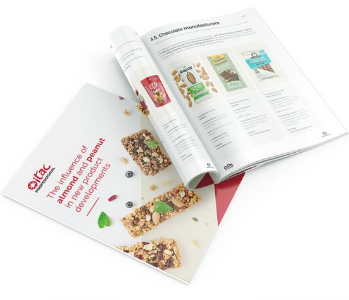Frozen foods are experiencing a true golden age, especially since the beginning of the pandemic, when consumers reduced their number of supermarket visits and rediscovered the wide and varied offer of frozen foods. But, where is innovation heading in this market? Do you want to know the latest frozen food trends in the food industry? What is the influence of nuts in all of this? Keep reading.
First, it is important to highlight that this re-emergence of frozen foods is not limited only to the consumption of common goods within this segment, such as frozen potatoes, pizzas, meat and fish. In fact, there are now new formulations and proposals that have managed to capture the attention of many consumers: frozen pasta, frozen snacks, low-carb Keto ice creams…
What drives frozen food consumers? Things like practicality, the increase of meals at home and premium frozen food products, which allow for a little treat at a competitive price, are encouraging sales in this sector. It is important to keep in mind that the consumer is now demanding frozen foods that offer the same quality, variety, protein/nutritional content and originality as fresh products, and because of this, innovation never stops in the frozen food industry.
How are frozen foods perceived?
Here, it must be said that new generations are shifting their perception in regard to the quality and nutritional value of these products. According to the 2021 Power of Frozen study by the AFFI (American Frozen Food Institute), Millennials are the generation that comprises the largest share of customers for this segment, at 48%. This same study corroborates that the trend shift brought about by the pandemic has consolidated in 2021, and the sale of these products has remained at 23% over pre-pandemic values.
What drives frozen food consumers?
Things like practicality, the increase of meals at home and premium frozen food products, which allow for a little treat at a competitive price, are encouraging sales in this sector. It is important to keep in mind that the consumer is now demanding frozen foods that offer the same quality, variety, protein/nutritional content and even originality as fresh products, and because of this, innovation never stops in the frozen food industry.
On the other hand, industrial manufacturers work, for example, on ready-to-eat frozen foods with cleaner labels and with more plant-based ingredients, where ingredients such as nuts and its processed forms have a growing importance.
What drives the frozen food industry?
Using data by the British Frozen Food Federation (BFFF) for the British market as an example, since 2019, the frozen foods category has experienced a 14.2% increase in value and a 10.4% in volumes. In view of this landscape, BFFF claims, industrial manufacturers are focusing their efforts on offering more innovative solutions, developing frozen products that are free from toxic substances, with more sustainable packagings and strengthening the plant-based claim and the nutritional benefits of the product.
On the other hand, the most innovative sectors, such as ice creams and ready-to-eat frozen foods, are trying to adapt to the requirements of a certain consumer profile in search of a personalised nutrition: frozen pizzas made with protein or fibre-rich doughs, frozen fruit mixes for smoothies, new lighter and healthier single-serving frozen snacks, etc.
You might be interested in: Latest food industry trends
Some frozen food trends that are driving innovation in this segment
Focusing on the latest frozen food trends, manufacturers have managed to revert the poor image this products had by going all-in on natural ingredients rich in functional benefits and that allow for new formulations of better quality, appearance and texture.
Let’s take a closer look at some of the leading trends in the frozen food industry:
Rebirth of ready-to-eat frozen foods
This segment is being particularly active and includes new and attractive claims in its packages to appeal to consumers:
- Claims regarding the product’s origin, such as Non-GMO, dye-free and artificial flavouring free.
- Functional benefits: low-fat or low-calorie, fibre-rich or protein-rich…
- Free from: lactose or gluten-free products.
In addition, many manufacturers are working to offer new international flavour proposals, and this is because, according to the AFFI, two-thirds of adults buy frozen foods to try their hand at a new cuisine. Moreover, they are working on new formats that allow the prepared dish to be personalised by adding more or less condiments or extra ingredients.
Keto Desserts
Ice creams and other desserts that are compatible with a Keto (ketogenic) diet, which is to say, low on carbs and rich in healthy fats, is yet another frozen food trend. These are basically ice creams that have nothing to envy from traditional ones when it comes to flavour and texture, but which have no sugar and use healthy alternative ingredients such as cocoa powder and nut butters.
Keep learning: Ice cream trends: towards more transparent and ethical ingredients
The boom of oven-ready frozen foods
Oven-ready frozen food products have experienced an unstoppable growth in the last few years since they can be prepared very fast and with little effort, and we have seen the emergence of new formats and flavours, both sweet and salty. Frozen dough is a solution that enables the baked goods industry to save time, but is also attracting end consumers and the hospitality industry.
Keep learning: Bakery industry trends: new fillings with nuts
New frozen snacks
The global trend towards a higher snack consumption throughout the day is also encouraging many manufacturers of sectors such as desserts to launch new frozen snack proposals experimenting with better-for-you claims and aiming to offer new moments for small indulgent treats.
Nuts, a key ingredient in the formulation of these products
Nuts are an ideal ingredient for the formulation of products that are a perfect fit for the new trends of the frozen food industry. A few examples are: the whole range of plant-based, much loved by those who follow vegetarian and vegan diets, and all kinds of gluten-free and lactose-free ice creams and desserts. In addition, nuts such as walnuts, almonds and peanuts strengthen the nutritional value of many pre-prepared frozen products, making them attractive for innovation teams within the food industry.
On the other hand, processed forms of nuts such as flour, powder and cream are also added to desserts, ice creams, frozen baked goods and many other segments since they are versatile and very appealing products from a functional perspective.
Put your trust in Itac Professional, the B2B of Grupo de Alimentación Importaco, if you are looking for a trusted nut supplier. Our track-record of over 75 years, combined with our commitment to innovation, will help you find a solution meets your expectations. Contact us for more information.
DISCOVER THE LATEST INNOVATIONS WITH ALMONDS AND PEANUTS IN NEW PRODUCT DEVELOPMENTS
Sources:
Speciality Food Magazine. What’s next for the frozen food trend?
Frozen Food. Millennials Have an Affinity for Frozen Food, AFFI Says
Institute of Food Technologists. Top 10 Food Trends of 2021






